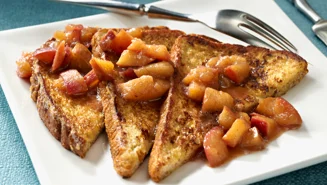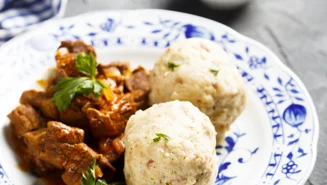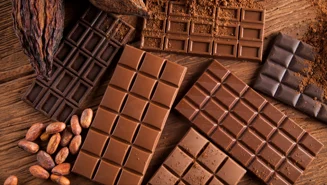
No, goat’s cheese is not lactose-free. Goat's cheese comes in various forms, ranging from fresh to aged and soft to hard. Each type has its unique lactose content based on its production methods and ageing.
While goat’s cheese generally contains less lactose than cow's cheese, the precise amount can vary based on specific production methods. Techniques such as certain fermentation processes or longer ageing can reduce lactose levels in the cheese.
Types of goat’s cheese and their lactose content
Cheeses that undergo longer periods of ageing and fermentation tend to have lower lactose levels. This is due to the breakdown of lactose into simpler sugars – glucose and galactose – which is done by adding lactic acid bacteria during the production process.
Fresh goat’s cheese, being less aged, contains higher amounts of lactose than its matured counterparts.
Below, you can see an overview of the lactose content in various types of goat's cheese:
Fresh goat's cheese
Fresh goat's cheese contains about 4-5 grams of lactose per 100 grams: This soft, creamy cheese is not aged and has a tangy flavour. As a fresh cheese, it generally contains higher amounts of lactose than longer-aged ones.
Aged goat's cheese
Aged goat's cheese contains about 2-3 grams of lactose per 100 grams: With time, the cheese becomes firmer and more flavourful. The lactose content is lower for this, as it typically decreases with ageing.
Semi-hard and hard goat's cheese
Semi-hard and hard goat's cheese contains 1-2 grams of lactose per 100 grams: These cheeses are aged longer, leading to a firmer texture. The lactose content is the lowest of the different types, as these semi-hard and hard cheeses mature longer.
You can read more about different cheese types and their lactose content in our article 'What is lactose-free cheese?'. Here, you can find the differences between fresh cheese, soft cheese, aged cheese, and more.
Goat’s cheese vs cow’s cheese
In a flavourful comparison between goat’s and cow’s cheese, the distinctions are not just about their lactose content. Goat's cheese, especially the fresh variety, usually has a tangy, earthy flavour and is often softer and creamier. Cow's cheese offers a wider range of flavours from mild to strong and can vary in texture from soft to semi-hard or hard.
In terms of lactose, while goat’s cheese typically contains a bit less lactose than cow’s cheese, the difference is not always substantial. Fresh goat's cheese has about 4-5 % lactose, while fresh cow’s cheese can have lactose levels ranging from 3-6 %. However, aged cheeses from both types of milk have lower lactose levels, some even less than 1 %.
You can read more in our article about lactose-free milk as well as our article about lactose-free goat's milk.
Goat’s cheese vs feta

Feta and goat’s cheese are both cherished for their tangy flavours, but there are fundamental differences. Feta is a brined cheese originating from Greece and is traditionally made from sheep's milk or a mixture of sheep's and goat's milk. It has a crumbly texture and a salty, tangy flavour.
Goat’s cheese, on the other hand, is made exclusively from goat's milk and can have various textures from soft to hard and crumbly. While they both have a tangy taste, goat’s cheese is often milder and creamier than feta.
When it comes to lactose, they both contain lower levels than cow’s cheese, but the specific amount varies from product to product and depends on the production process. Feta typically has a lactose content of about 4-5 %. Read more in our article 'Is feta lactose-free?'.
To learn more, take a look at our overviews of cheeses with lower lactose content and cheeses with higher lactose content.
Enjoy the good flavour of lactose-free goat’s cheese
Lactose-free goat’s cheeses undergo special production processes to remove lactose while maintaining their authentic taste and texture. Also, the versatile nature of lactose-free goat’s cheese allows you to elevate an array of dishes, from salads and pasta to pizza and baked goods.
You can crumble it over salads, adding a tangy and creamy contrast to the fresh greens and vegetables. It also pairs wonderfully with fruits such as figs, pears, or berries for a delightful appetiser or snack.
Mixing it into pasta dishes, such as a creamy sauce or stuffed shells, can provide a rich and satisfying meal. If you are looking for a simple yet delicious treat, try spreading it on a slice of crusty bread or crackers, or use it as a topping on your favourite pizza to add a special twist to a classic favourite.
Baking with lactose-free goat’s cheese can also result in delightful dishes, such as savoury quiches or tarts, where its creamy texture complements the crisp crust.









































